Abstract
The aim of this project was to determine the acceptability and usefulness of an educational videotape for African Americans with depression. Four focus groups were held in two community settings and at a historically black university. Subjects included 24 African Americans, aged 18-76 years, who screened positive for depression. Focus group questions addressed the usefulness of the videotape to understand depression and its treatment, the most and least effective parts of the videotape, and the cultural appropriateness of the information presented. Participants took pre- and post-tests on attitudes about depression. Discussions were audiotaped, transcribed, and reviewed independently by two investigators to identify and group comments into specific themes. Two other investigators reviewed the themes and comments for consistency and relevance. The videotape was generally well received and was rated effective in improving knowledge about depression and its treatment. After watching the videotape, attitudes improved in several areas, including depression as a medical illness, effectiveness of treatment, negative perceptions of antidepressant medication and reliance upon spirituality to heal depression. This culturally tailored videotape about depression is deemed acceptable and effective for most African Americans with depression participating in focus groups. It also improved knowledge and several attitudes about depression.
Full text
PDF
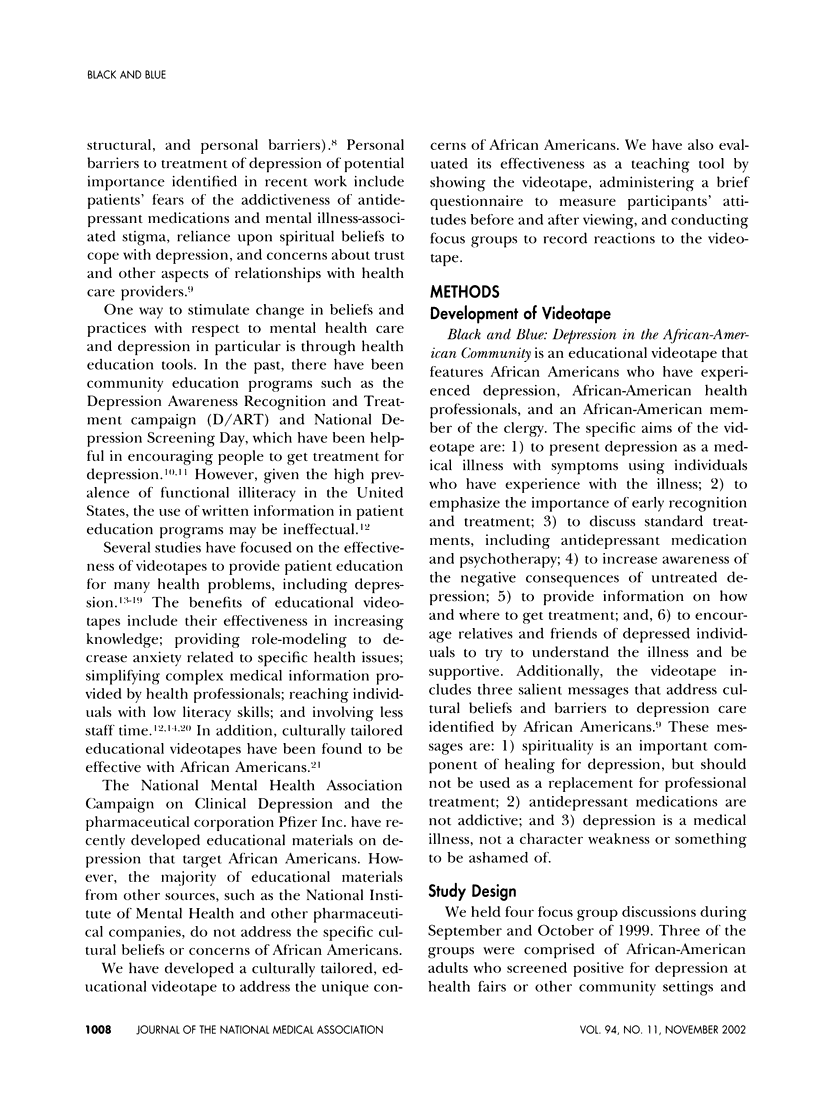

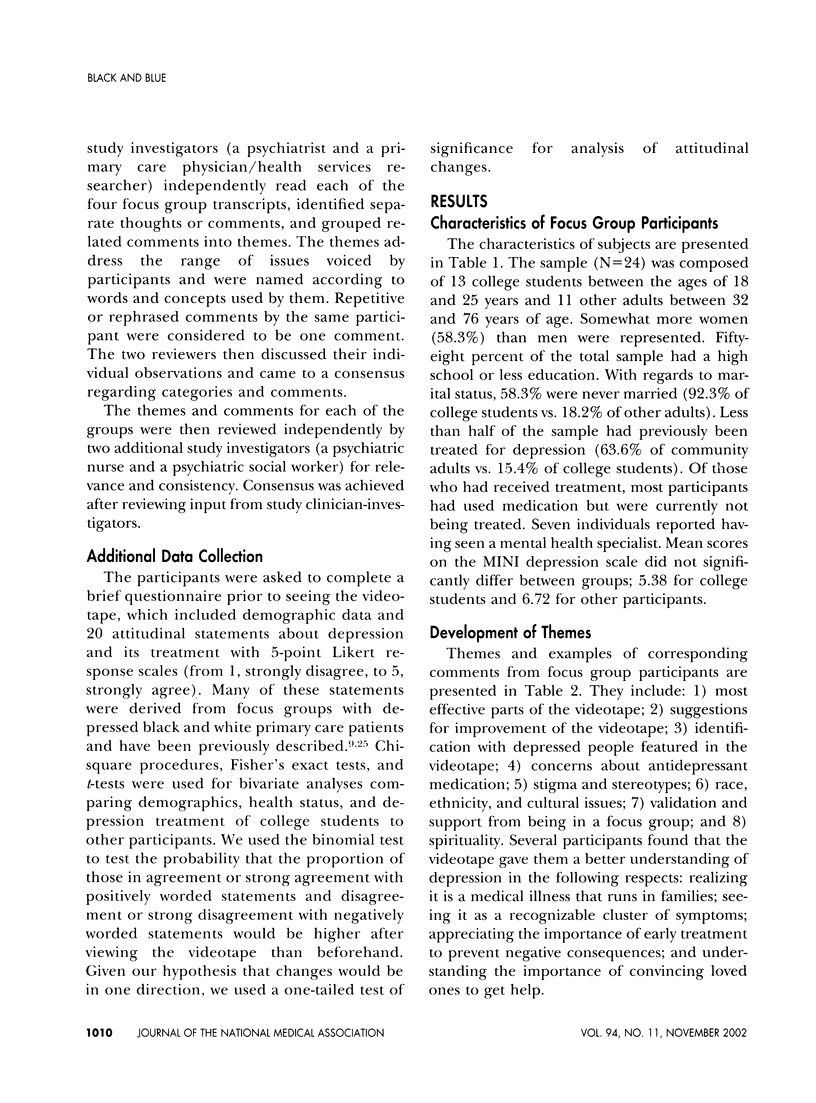
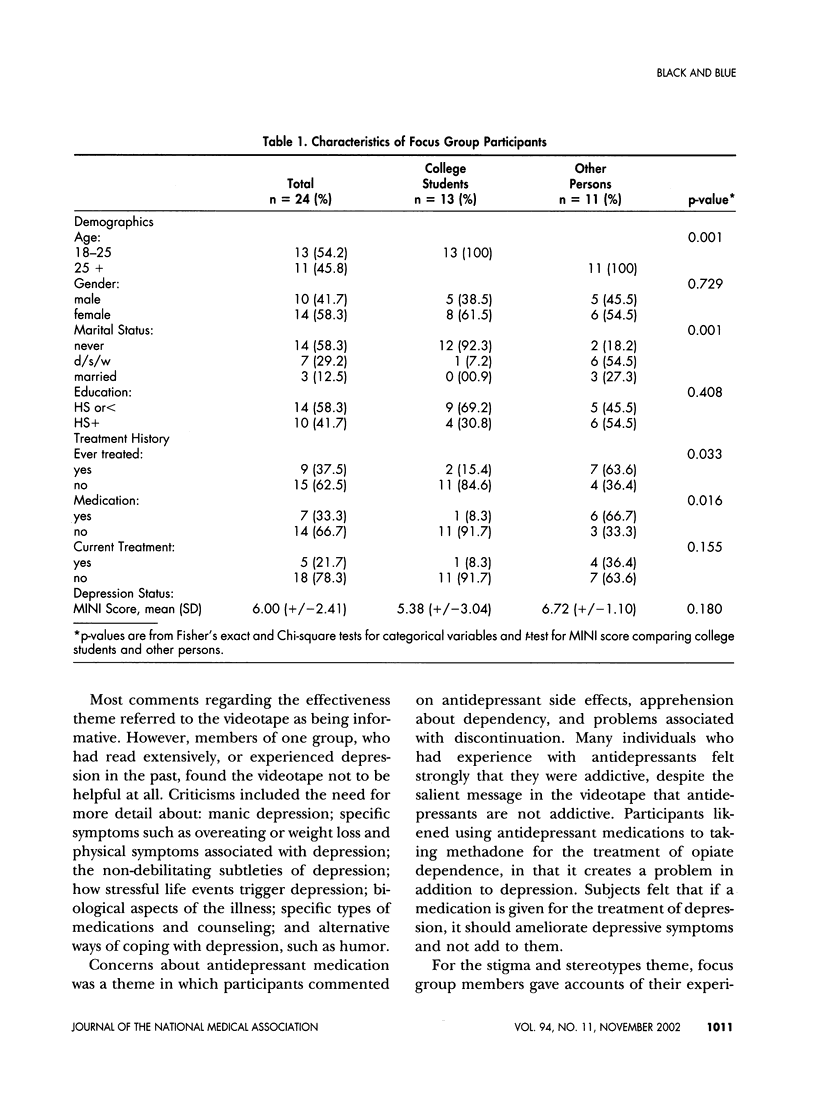
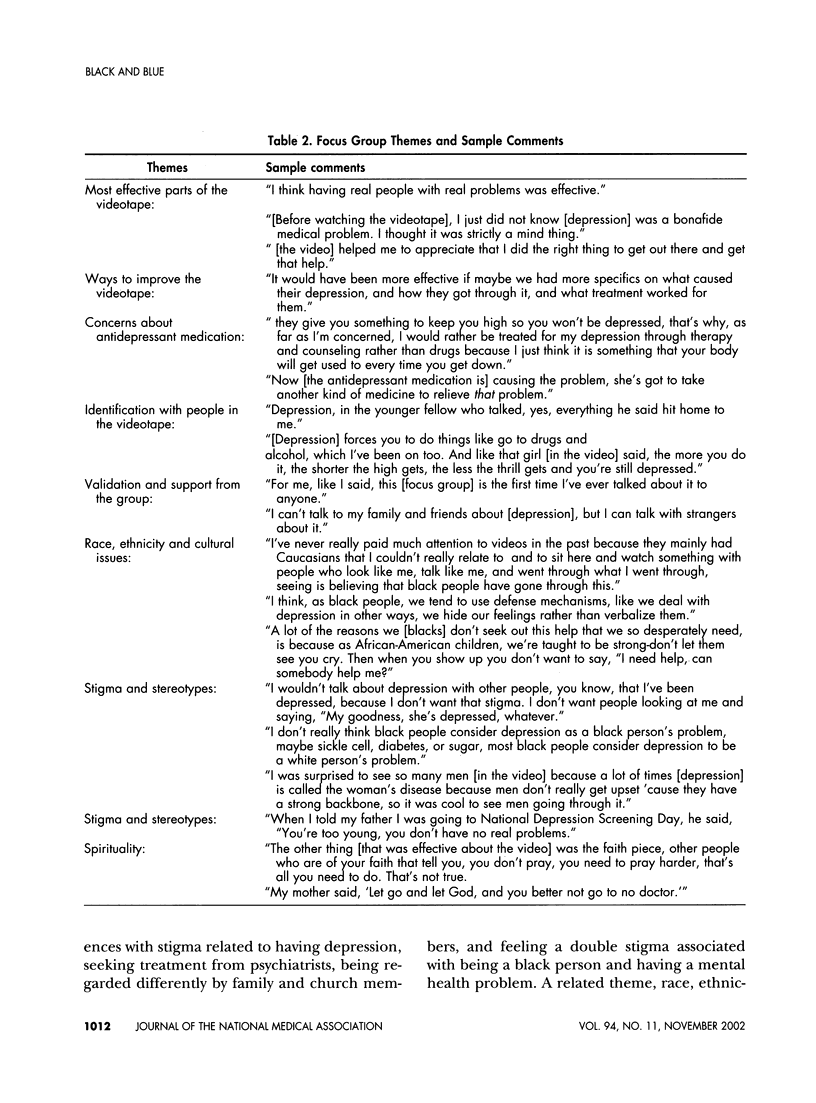
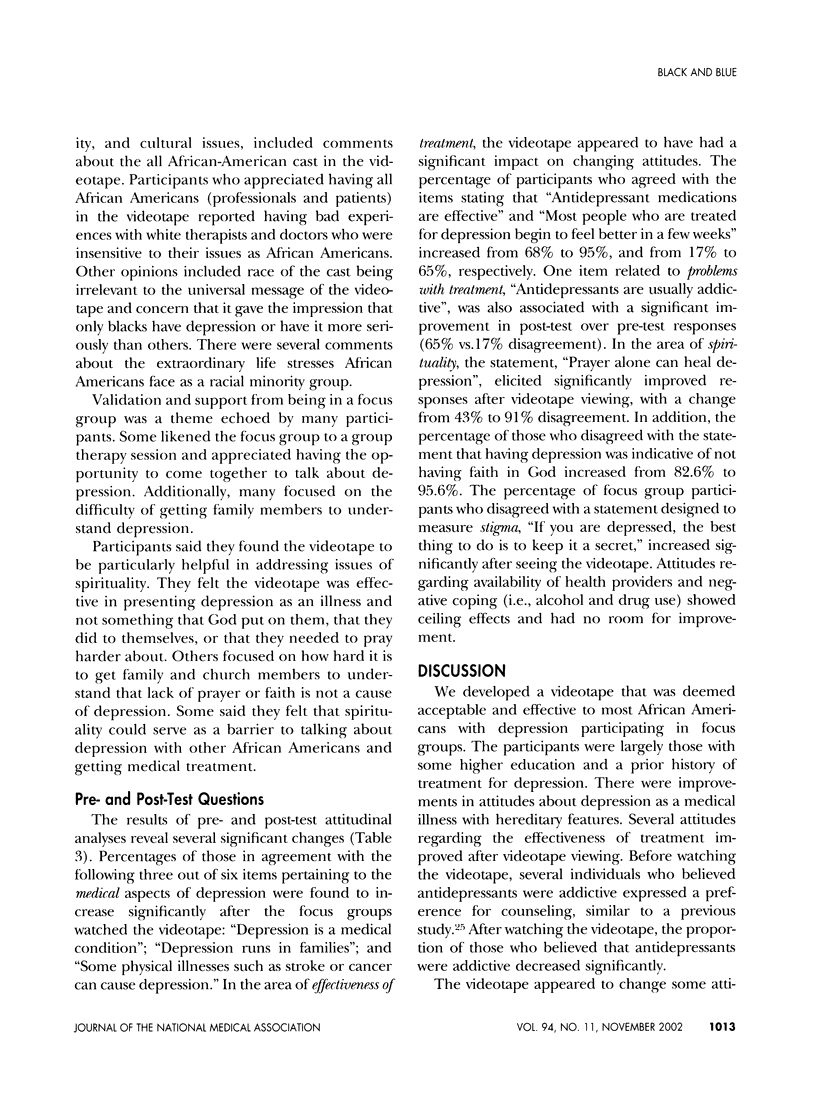



Selected References
These references are in PubMed. This may not be the complete list of references from this article.
- Chachkes E., Christ G. Cross cultural issues in patient education. Patient Educ Couns. 1996 Jan;27(1):13–21. doi: 10.1016/0738-3991(95)00785-7. [DOI] [PubMed] [Google Scholar]
- Cohen D. The effectiveness of videotape in patient education on depression. J Biocommun. 1983 Mar;10(1):19–23. [PubMed] [Google Scholar]
- Cooper-Patrick L., Powe N. R., Jenckes M. W., Gonzales J. J., Levine D. M., Ford D. E. Identification of patient attitudes and preferences regarding treatment of depression. J Gen Intern Med. 1997 Jul;12(7):431–438. doi: 10.1046/j.1525-1497.1997.00075.x. [DOI] [PMC free article] [PubMed] [Google Scholar]
- Gagliano M. E. A literature review on the efficacy of video in patient education. J Med Educ. 1988 Oct;63(10):785–792. doi: 10.1097/00001888-198810000-00006. [DOI] [PubMed] [Google Scholar]
- Hirschfeld R. M., Keller M. B., Panico S., Arons B. S., Barlow D., Davidoff F., Endicott J., Froom J., Goldstein M., Gorman J. M. The National Depressive and Manic-Depressive Association consensus statement on the undertreatment of depression. JAMA. 1997 Jan 22;277(4):333–340. [PubMed] [Google Scholar]
- Hu T. W., Snowden L. R., Jerrell J. M., Nguyen T. D. Ethnic populations in public mental health: services choice and level of use. Am J Public Health. 1991 Nov;81(11):1429–1434. doi: 10.2105/ajph.81.11.1429. [DOI] [PMC free article] [PubMed] [Google Scholar]
- Mayeaux E. J., Jr, Murphy P. W., Arnold C., Davis T. C., Jackson R. H., Sentell T. Improving patient education for patients with low literacy skills. Am Fam Physician. 1996 Jan;53(1):205–211. [PubMed] [Google Scholar]
- Meade C. D., McKinney W. P., Barnas G. P. Educating patients with limited literacy skills: the effectiveness of printed and videotaped materials about colon cancer. Am J Public Health. 1994 Jan;84(1):119–121. doi: 10.2105/ajph.84.1.119. [DOI] [PMC free article] [PubMed] [Google Scholar]
- Meymandi A., Deaver E. L. A new paradigm in patient education: a four-part model using videotape production. J Psychiatr Ment Health Nurs. 1999 Jun;6(3):181–185. doi: 10.1046/j.1365-2850.1999.630181.x. [DOI] [PubMed] [Google Scholar]
- Neighbors H. W., Jackson J. S. The use of informal and formal help: four patterns of illness behavior in the black community. Am J Community Psychol. 1984 Dec;12(6):629–644. doi: 10.1007/BF00922616. [DOI] [PubMed] [Google Scholar]
- Neighbors H. W., Musick M. A., Williams D. R. The African American minister as a source of help for serious personal crises: bridge or barrier to mental health care? Health Educ Behav. 1998 Dec;25(6):759–777. doi: 10.1177/109019819802500606. [DOI] [PubMed] [Google Scholar]
- Neighbors H. W. The help-seeking behavior of black Americans. A summary of findings from the National Survey of Black Americans. J Natl Med Assoc. 1988 Sep;80(9):1009–1012. [PMC free article] [PubMed] [Google Scholar]
- Resnicow K., Royce J., Vaughan R., Orlandi M. A., Smith M. Analysis of a multicomponent smoking cessation project: what worked and why. Prev Med. 1997 May-Jun;26(3):373–381. doi: 10.1006/pmed.1997.0157. [DOI] [PubMed] [Google Scholar]
- Robinson P., Katon W., Von Korff M., Bush T., Simon G., Lin E., Walker E. The education of depressed primary care patients: what do patients think of interactive booklets and a video? J Fam Pract. 1997 Jun;44(6):562–571. [PubMed] [Google Scholar]
- Scheffler R. M., Miller A. B. Demand analysis of mental health service use among ethnic subpopulations. Inquiry. 1989 Summer;26(2):202–215. [PubMed] [Google Scholar]
- Schotte C., Maes M., Beuten T., Vandenbossche B., Cosyns P., Van Coppenolle F. A videotape as introduction for cognitive behavioral therapy with depressed inpatients. Psychol Rep. 1993 Apr;72(2):440–442. doi: 10.2466/pr0.1993.72.2.440. [DOI] [PubMed] [Google Scholar]
- Sheehan D. V., Lecrubier Y., Sheehan K. H., Amorim P., Janavs J., Weiller E., Hergueta T., Baker R., Dunbar G. C. The Mini-International Neuropsychiatric Interview (M.I.N.I.): the development and validation of a structured diagnostic psychiatric interview for DSM-IV and ICD-10. J Clin Psychiatry. 1998;59 (Suppl 20):22–57. [PubMed] [Google Scholar]
- Stone S., Holden A., Knapic N., Ansell J. Comparison between videotape and personalized patient education for anticoagulant therapy. J Fam Pract. 1989 Jul;29(1):55–57. [PubMed] [Google Scholar]
- Sussman L. K., Robins L. N., Earls F. Treatment-seeking for depression by black and white Americans. Soc Sci Med. 1987;24(3):187–196. doi: 10.1016/0277-9536(87)90046-3. [DOI] [PubMed] [Google Scholar]
- Vernon S. W., Roberts R. E. Prevalence of treated and untreated psychiatric disorders in three ethnic groups. Soc Sci Med. 1982;16(17):1575–1582. doi: 10.1016/0277-9536(82)90168-x. [DOI] [PubMed] [Google Scholar]
- Williams S. J., Diehr P., Drucker W. L., Richardson W. C. Mental health services: utilization by low income enrollees in a prepaid group practice plan and in an independent practice plan. Med Care. 1979 Feb;17(2):139–151. doi: 10.1097/00005650-197902000-00004. [DOI] [PubMed] [Google Scholar]
- Wilson J. L., Stein D. S. The impact of public education videotapes on knowledge about cancer. J Cancer Educ. 1997 Spring;12(1):51–54. doi: 10.1080/08858199709528451. [DOI] [PubMed] [Google Scholar]


